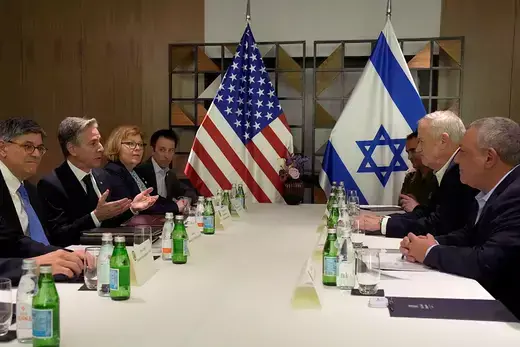Steven A. Cook
Continuing efforts to broker a deal throughout the Middle East still could succeed, despite the latest failed effort to pause the fighting in the Gaza Strip and secure a hostage release.
What does Israel’s rejection of the latest cease-fire plan in the Gaza Strip mean for prospects of a pause in the fighting and a hostage release deal?
It is important to keep in mind that the Israeli government’s dismissal of the U.S.-backed deal proposed by Egypt and Qatar on a cease-fire agreement was not a complete rejection. The primary sticking points seem to have been Hamas’s goal of transforming the cease-fire into a sustained truce, its demands that Israel fully withdraw from Gaza during the cessation of hostilities, and the release of 1,500 Palestinians held in Israeli jails, including 500 who are serving long-term sentences for violence against Israelis.
Prisoners for hostage deals have become a sensitive political issue in Israel. In 2011, the Israeli government agreed to a deal brokered by Egypt and Germany that exchanged about one thousand Palestinians in Israeli jails for a single Israeli soldier named Gilad Shalit, who Hamas had held hostage for five years. Among those exchanged was Yahya Sinwar, reported to be the mastermind of the October 7 terrorist attacks in Israel that precipitated the ongoing war in Gaza. Netanyahu’s coalition partner, Public Security Minister Itamar Ben Gvir, has been clear that he would bolt the government if the cease-fire included the exchange of large numbers of Palestinians, especially those accused of spilling Israeli blood. Ben Gvir may be bluffing, but it is not likely one that Netanyahu can politically afford to call. At the same time, the prime minister is under heavy pressure from the families of hostages to suspend the war to bring their loved ones home.
Was this a setback for the United States and what options does it have to press for a new deal? What did Secretary of State Antony Blinken find in his recent round of diplomacy in the region?
A weekly digest of the latest from CFR on the biggest foreign policy stories of the week, featuring briefs, opinions, and explainers. Every Friday.
It was a setback, but a qualified one. The Joe Biden administration is under pressure both at home and abroad to bring fighting to an end. Polls demonstrate that Americans support a cease-fire. There are some signs that the negotiations are not over. In the coming days, representatives of Hamas are heading to Cairo for talks, and the Palestinian Authority President Mahmoud Abbas is reportedly traveling to Doha to consult with Qatari leaders. The job of diplomats is sometimes to make something out of nothing. By dint of the planned diplomatic activity, it is possible to infer that Blinken and his counterparts in the region believe they can still produce an agreement.

U.S. Secretary of State Antony Blinken meets with former Israel Defense Forces (IDF) chief Gadi Eisenkot and former Israeli Defense Minister Benny Gantz in Israel on February 8, 2024. Mark Schiefelbein/Pool/Reuters
The Israelis remain interested in a cease-fire, but they do not want a cessation of fighting to provide Hamas with the opportunity to regroup. They also do not want a cease-fire to become a de facto armistice, believing that Israel’s security would remain in jeopardy. Since the beginning of the war, the Israelis have insisted that international pressure will not deter them from achieving their war aims, principally the destruction of Hamas. It is unclear how much damage the Israel Defense Forces (IDF) have done to Hamas. The Israelis indicate that they have killed or wounded two-thirds of Hamas fighters and destroyed seventeen of the group’s twenty-four battalions in Gaza. The Israelis are clearly willing to countenance international opprobrium for rejecting what they regard as a bad cease-fire deal that will allow Hamas to survive and fight another day.
What interim measures can be enacted to relieve Gaza’s humanitarian plight, including the Palestinian civilians?
The situation in the Gaza Strip is extremely difficult, especially as the IDF bears down on Rafah, the southernmost city in the area. Rafah was previously home to about 300,000 people but is now sheltering nearly 1.4 million people—more than half the Gazan population. UN officials who have crossed the border from Egypt describe a grim humanitarian situation.
To make matters more complicated, sixteen countries and the European Union have suspended contributions to the United Nations Relief Works Agency (UNRWA), which provides aid to Palestinian refugees, because about a dozen of its employees were allegedly involved in the October 7 attacks. This is likely to make matters worse, though the situation may not be as dire in the short run as some have suggested. At the time of the suspension, the United States, which is the largest contributor to the agency, had already donated most of its annual contribution to UNRWA. The agency says it received hundreds of millions of dollars from the United States in 2023.
Members of Congress, including both Democrats and Republicans, are determined to end U.S. support for UNRWA, but there is not yet a plan for any other UN agency or combination of international nongovernmental organizations to fill the void if UNRWA disbanded.
No comments:
Post a Comment